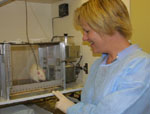Study to test cocaine addiction relapse medication
A derivative of a common amino acid has been found to be effective in preventing relapse to cocaine use in experimental animals. The findings by MUSC researchers will be published in the July issue of Nature Neuroscience. Another team of MUSC investigators has begun testing the compound in humans. Dr.
Peter Kalivas
Dr.
Peter Kalivas
“Addiction to drugs of abuse causes permanent changes in the brain that can cause addicts to crave the drug for years after last using the drug,” said Peter Kalivas, Ph.D., chair of the Department of Physiology and Neurosciences at MUSC and an author of the study. Through funding from the National Institute of Drug Abuse, Kalivas and his colleagues have been investigating the nature of these changes with the hope that once the changes are characterized, they will point to new treatments and even cures for addiction.
The published paper describes a surprising change produced in the brains of cocaine-addicted rats, and when this change is reversed, the animals no longer demonstrated addicted behavior. They also found that the addicted behavior was reversed by the amino acid derivative, N-acetylcysteine, which is used as a food supplement, antioxidant and a treatment for acetaminophen (Tylenol) overdose.
Because of the highly promising results in the animal trials, a second group of MUSC researchers, working in close consultation with the first team, designed a clinical trial to test the safety and efficacy of the compound on humans. They recruited cocaine-addicted individuals to participate. To date two individuals have been tested.
 Dr.
Robert Malcolm
Dr.
Robert Malcolm
“We are very excited about this research,” said Robert Malcolm, M.D., an MUSC psychiatrist, specializing in addiction and principal investigator in the clinical trial. “Cocaine addiction is a major public health problem and current treatments are not effective. This drug appears to be very promising, and the trial will provide valuable information. Our ultimate goal is to provide relief to addicts who are desperately seeking help.”
The participant in the human research trial, who must be free of cocaine for three days prior to the trial, is admitted to the university’s General Clinical Research Center, a highly specialized patient unit designed for clinical research. During the first week, the participant is given four doses of either the compound or placebo, and the second week he is given the opposite, with neither the patient nor investigators knowing in which week, which compound is administered.
During the trial, the subject is carefully monitored for adverse reaction to the compound. Additionally, following administration of either the compound or placebo, the subject is tested for craving reaction in two ways. He/she is placed in a high speed MRI, where researchers can observe changes in the brain related to a craving response when the subject is shown pictures of people using cocaine or drug paraphernalia. Additionally, physiological responses to drug cues such as sweating, heart rate and facial muscles are also monitored.
The researchers anticipate that the preliminary trial with 12 patients will be completed early in 2004.
 Department
of Physiology and Neurosciences' Dr. Krista McFarland, co-investigator
of a study to be published in the July issue of Nature Neuroscience, observes
one of the study's subjects. The line to the rat's back enables researchers
to deliver the cocaine directly to the animal's bloodstream. The rat learns
that when he presses the lever, he receives an intravenous infusion of
cocaine. The study found that a compound reduced rats' craving for cocaine.
Another team of MUSC investigators have begun a clinical trial on this
compound.
Department
of Physiology and Neurosciences' Dr. Krista McFarland, co-investigator
of a study to be published in the July issue of Nature Neuroscience, observes
one of the study's subjects. The line to the rat's back enables researchers
to deliver the cocaine directly to the animal's bloodstream. The rat learns
that when he presses the lever, he receives an intravenous infusion of
cocaine. The study found that a compound reduced rats' craving for cocaine.
Another team of MUSC investigators have begun a clinical trial on this
compound.
In the animal trial the researchers discovered that there is a marked reduction in the levels of a neurotransmitter called glutamate in the part of the brain long known to be important in addiction called the nucleus accumbens. They found that the lower glutamate levels occurred because a protein called the cystine-glutamate exchanger was defective. Treatment with N-acetylcysteine increased the activity of the exchanger and restored glutamate levels to normal. When N-acetylcysteine had restored the levels of glutamate the rats no longer engaged in drug-seeking behavior which is a model of craving and relapse in human addicts. Importantly, N-acetylcysteine had no effect on seeking other rewards, such as food.
MUSC researchers participating in the animal trial along with Kalivas are David Baker, Ph.D., Krista McFarland, Ph.D., Russell W. Lake, Hui Shen, M.D., Xing-Chun Tang, M.D., and Shigenobu Toda, M.D. The paper can be viewed online at http://www.nature.com/neuro/.
Developed with the assistance of Kathleen Brady, M.D., Ph.D., the clinical
trial is being conducted by Malcolm, Steven LaRowe, Ph.D., and Hugh Myrick,
M.D.
Catalyst Online is published weekly, updated as
needed and improved from time to time by the MUSC Office of Public Relations
for the faculty, employees and students of the Medical University of South
Carolina. Catalyst Online editor, Kim Draughn, can be reached at 792-4107
or by email, catalyst@musc.edu. Editorial copy can be submitted to Catalyst
Online and to The Catalyst in print by fax, 792-6723, or by email to petersnd@musc.edu
or catalyst@musc.edu. To place an ad in The Catalyst hardcopy, call Community
Press at 849-1778.